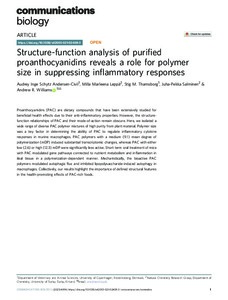Structure-function analysis of purified proanthocyanidins reveals a role for polymer size in suppressing inflammatory responses
Salminen Juha-Pekka; Williams Andrew R.; Thamsborg Stig M.; Andersen-Civil Audrey Inge Schytz; Leppä Milla Marleena
Structure-function analysis of purified proanthocyanidins reveals a role for polymer size in suppressing inflammatory responses
Salminen Juha-Pekka
Williams Andrew R.
Thamsborg Stig M.
Andersen-Civil Audrey Inge Schytz
Leppä Milla Marleena
NATURE RESEARCH
Julkaisun pysyvä osoite on:
https://urn.fi/URN:NBN:fi-fe2021093048736
https://urn.fi/URN:NBN:fi-fe2021093048736
Tiivistelmä
Proanthocyanidins (PAC) are dietary compounds that have been extensively studied for beneficial health effects due to their anti-inflammatory properties. However, the structure-function relationships of PAC and their mode-of-action remain obscure. Here, we isolated a wide range of diverse PAC polymer mixtures of high purity from plant material. Polymer size was a key factor in determining the ability of PAC to regulate inflammatory cytokine responses in murine macrophages. PAC polymers with a medium (9.1) mean degree of polymerization (mDP) induced substantial transcriptomic changes, whereas PAC with either low (2.6) or high (12.3) mDP were significantly less active. Short-term oral treatment of mice with PAC modulated gene pathways connected to nutrient metabolism and inflammation in ileal tissue in a polymerization-dependent manner. Mechanistically, the bioactive PAC polymers modulated autophagic flux and inhibited lipopolysaccharide-induced autophagy in macrophages. Collectively, our results highlight the importance of defined structural features in the health-promoting effects of PAC-rich foods.
Kokoelmat
- Rinnakkaistallenteet [19207]
